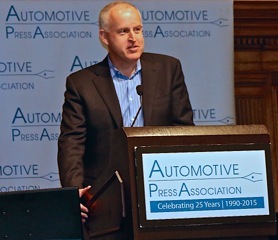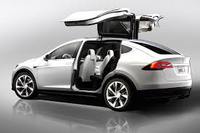Tesla Updates Detroit
 Tesla Vice President of Corporate and Business Development, Diarmuid O'ConnellO'Connell At Detroit APA |
SEE ALSO: Tesla Research and Buyers Guide
TESLA UPDATE
By Steve Purdy and Martha Hindes
The Auto Channel, Michigan Bureau
Photo by Bob Benko
 |
Mr. O’Connell talked about Tesla no longer being a “niche” company, now becoming an “above the fold issue.” He reminded the audience that Tesla’s mission is “to accelerate the world’s transition to sustainable transportation.” Indeed, founder, CEO and chief thinker for the company Musk is pursuing a variety of transportation projects beyond automobiles, like a blindingly fast tube between San Francisco and Los Angeles, a solar power company and Space X to name just a few.
 |
These cars, he insists, influenced the development of dozens of electric and plug-in hybrids from other manufacturers but most of those were designed to meet government mandates and regulatory requirements rather than as purely innovative electric vehicles. Mr. O’Connell thinks we need more competition in the business and more independent thinking.
Touting Tesla’s current products he called the Model S “the safest car ever” and talked about it’s accomplishments like a 0-to-60 mph time of 2.8 seconds and beating all its competitors in sales. Not bad for the youngest car company in the world.
Finally, Mr. O’Connell spent some time on the current regulatory environment effecting electric car development and how that might change. He used the metaphor of carrots and sticks to describe how the EPA, NHTSA, CARB, various highway authorities and a seemingly unlimited number of other agencies will use their powers for good or evil as the electric car market continues to develop from the very small position they have now.
During the Q & A some in the audience wanted to get Tesla’s take on the future of hydrogen fuel-cell electric vehicles – a fuel source that conventional wisdom continues to favor for the long run.
As auto manufacturers globally battle with the need to make the cars and trucks they produce more fuel efficient and less polluting, the young company that has emerged at the head of the electric vehicle transition is turning thumbs down on a potential technology that proponents say promises to solve all those challenges. Twelve-year-old California-based Tesla, the visionary brainchild of PayPal energizer and South Africa native Elon Musk, has emerged from a position of curiosity, to acceptance to near-leadership in the electric vehicle (EV) field during its short lifetime.
But Mr. O’Connell, who admittedly has no background in the auto industry, was quick to dismiss the idea that Tesla was missing a main shift in the future. That as more auto manufacturers such as Nissan and Toyota begin introduction of early fuel cell vehicles into the mainstream the infrastructure will develop.
A chief reason Tesla won't go in that direction can be summed up in that one word, he said. That is infrastructure. On the EV side, Tesla has aggressively expanded a widespread network of charging stations first in the U.S. beginning along the west coast now covering the entire U.S. and subsequently in Western Europe and some in China. And, he said, an electric car can be charged from virtually any electric outlet. By contrast, fuel cell vehicles would need hydrogen fill-ups to operate and the infrastructure to produce and distribute the hydrogen will be prohibitively expensive.
However, O'Connell didn't touch on the history that, following a stunning announcement by then Chrysler Corp in the early 1990s, it would develop fuel cell vehicles. Major American, European and Asian manufacturers have spent a quarter century and many billions of dollars developing that elusive technology. Fuel cells that do not burn fuel but operate with energy derived from a chemical reaction from the splitting then re-assembling of hydrogen molecules have been a tantalizing incentive for the industry. The payoff would be a vehicle with only water vapor as an emission and no need for fossil fuels to operate.
EV critics often mention the potential NIMBY problem, where emission fallout from electricity production -- often the dirty kind -- comes from static electrical plants rather than from vehicles on the road, keeping their pollution in more centralized regions. General Motors, with a long history of electric vehicle development going back to the EV1, is only one of the main vehicle manufacturers continuing to research and develop improvements in the internal combustion (IC) engine, the industry's main way of powering autos for more than a century. O'Connell cited the need to abandon IC as a viable way of propelling vehicles and convert the industry to electrically powered autos and trucks.
© Steve Purdy and Martha Hindes, All Rights Reserved


